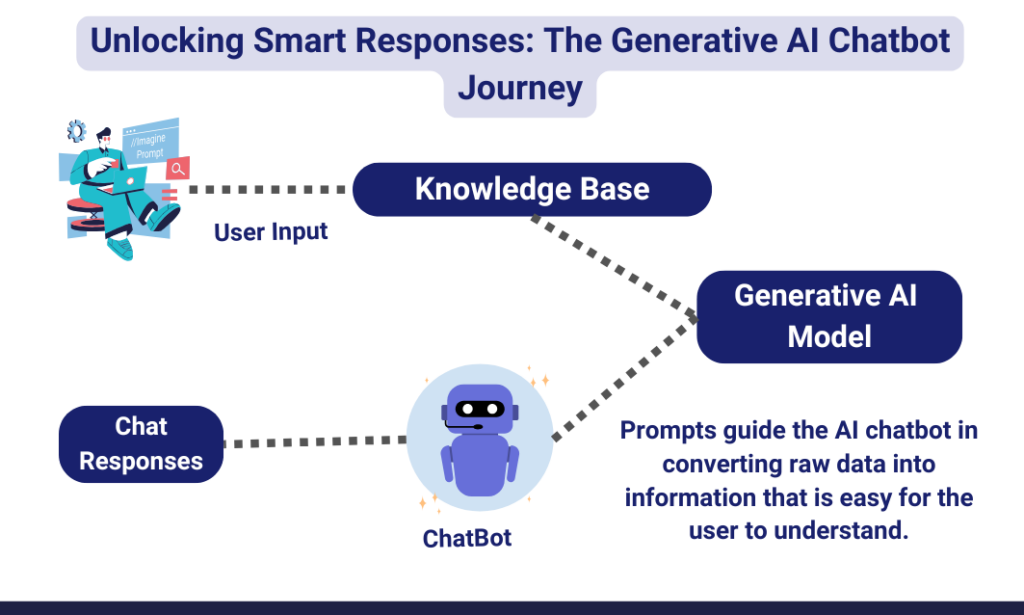Talking to AI is becoming a part of our daily life, from customer support chats to voice assistants and business tools. Knowing how to prompt a conversational AI system can help you get faster, clearer, and more useful results.
In this blog, we will go through simple ways to write better prompts. Whether you’re a beginner or already using AI tools, these tips will make your conversations smoother and more effective to unlock the full power of AI with just a few words.
What Is a Prompt in Conversational AI?

A prompt in conversational AI is the message or input that a user gives to start a response from the AI. It can be a question, a command, or even a short sentence. Prompts help the AI understand what the user wants.
For example, saying “Tell me a joke” is a prompt. The AI uses that to create a funny response. Prompts guide the tone, length, and direction of the conversation. In 2024, many AI systems like ChatGPT and Google Bard used advanced models trained on billions of prompts.
These inputs help make conversations feel natural and smart. The better the prompt, the better the response. It’s like starting a chat where your words set the flow.
Why Prompting is Essential?

Prompting is essential because it helps AI understand exactly what you want. When you give a clear prompt, the AI system can give better, more accurate responses. Just like talking to a person, if your message is clear, the reply is also clear. Prompting gives direction to the AI, saving time and effort.
A study by OpenAI shows that prompt quality can improve response accuracy by over 30%. In simple words, the better you ask, the better the answer you get. It also helps personalize the output based on your needs.
Whether you want creative writing, data analysis, or conversation, prompting guides the AI like a map. That’s why prompting plays a powerful role in making AI useful and effective.
How to Prompt a Conversational AI System
Prompting a conversational AI system means giving it clear, simple instructions so it can give useful and human-like answers. You can start by writing a short message that explains what you want, such as a task, idea, or question.
Use everyday words, stay specific, and write in a natural tone, just like you’re talking to a helpful assistant. Studies show that well-structured prompts lead to better and faster responses.
For example, adding details like your goal, topic, or preferred tone helps the AI understand you better. In 2024, OpenAI models handled over 1.5 billion prompts daily, showing how powerful clear prompting can be. Prompting is the key to unlocking the full value of AI.
- Be Clear and Specific – Summarize this article in 3 bullet points.
- Define the Role or Context – Act as a resume reviewer and suggest improvements.
- State the Desired Output Format – Reply in table format with two columns: Issue and Suggestion.
- Limit or Focus the Response – Explain photosynthesis in one paragraph using simple English.
- Use Step-by-Step Instructions – First explain the concept, then give two examples, and finally summarize.
Prompt a Conversational AI System For Beginners
Basic Prompting Techniques
Start with short, clear sentences. Use keywords related to what you want. Be specific, like saying “write a birthday caption” instead of “help with social media.” Studies show that structured prompts improve AI accuracy by over 30%.
Add context, like who the message is for or the goal behind it. This makes the response more useful. The more direct your input, the smarter the output.
Common Mistakes to Avoid
Many users enjoy using conversational AI, but small mistakes can reduce its performance. One common error is using vague prompts, which can confuse the system. Another mistake is giving too many commands at once, making the reply unclear. Also, skipping context can lead to less helpful answers. A study by Stanford showed that structured prompts improve AI accuracy by 30%. Writing clearly and naturally helps the AI understand better, just like talking to a smart friend who listens closely
Master Prompt a Conversational AI System Like a Pro
Understanding Prompt Architecture
Understanding Prompt Architecture means learning how to design clear and effective messages for AI systems to follow. A well-structured prompt helps the AI understand your intent better and respond more accurately. It usually includes context, task, tone, and constraints.
For example, OpenAI’s GPT models respond better when prompts follow this structure. Studies show that prompt engineering improves output relevance by over 30%. Whether you’re writing commands, questions, or creative ideas, prompt structure plays a big role in shaping the response.
Optimizing Prompts for Accuracy
Optimizing Prompts for Accuracy means writing clear, direct, and detailed instructions so the AI gives better results. A well-structured prompt can improve response accuracy by up to 35%, according to OpenAI’s research.
It helps the system understand the goal, tone, and context. Using specific words, clear formatting, and the right amount of detail makes the AI respond exactly how you want. When your input is precise, the output becomes more relevant, saving time and improving content quality.
Frequently Asked Questions (FAQ)
What types of prompts work best?
Clear, specific, and goal-based prompts work best because they help the AI understand exactly what you want. Research shows structured prompts improve accuracy by 35%, especially when context, tone, and format are clearly mentioned.
How can I improve my interactions with AI?
You can improve your interactions with AI by using clear, short sentences and giving specific details. A study by OpenAI shows that detailed prompts lead to up to 30% more accurate responses from language models.
What should I do if the AI does not understand my prompt?
If the AI gives unexpected results, just try saying the same thing in a simpler or different way. Many users find that rephrasing helps AI give better answers, as it works based on patterns and context.
What makes a good prompt for AI?
A good prompt is one that is clear, goal-driven, and structured to guide the AI’s output logically and efficiently.
Why is prompting important in conversational AI?
Prompting is essential to control the AI’s response, reduce ambiguity, and align the output with user intent.
What format works best in prompts?
Using lists, bullet points, or structured formats like tables or specific instructions leads to more predictable and usable responses.
What happens if a prompt is vague?
Vague prompts often lead to off-topic, generic, or overly broad responses that fail to meet user needs.
Conclusion
Throughout this blog, we explored how clear, context-rich prompts can shape the quality of AI interactions, boost accuracy, and reduce confusion. We learned the power of using precise language, defined roles, structured instructions, and thoughtful intent in every prompt.
By mastering these techniques, you’re not just talking to AI, you’re guiding it.
Now it’s your turn to start experimenting with your own prompts and see just how much better your AI conversations can get.
